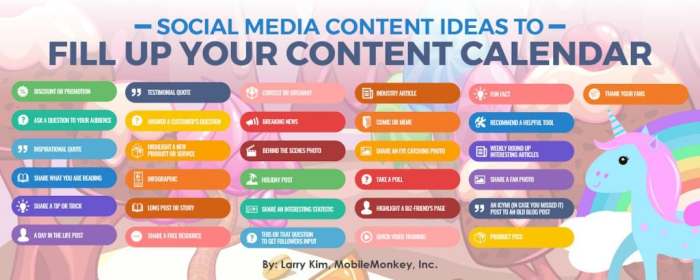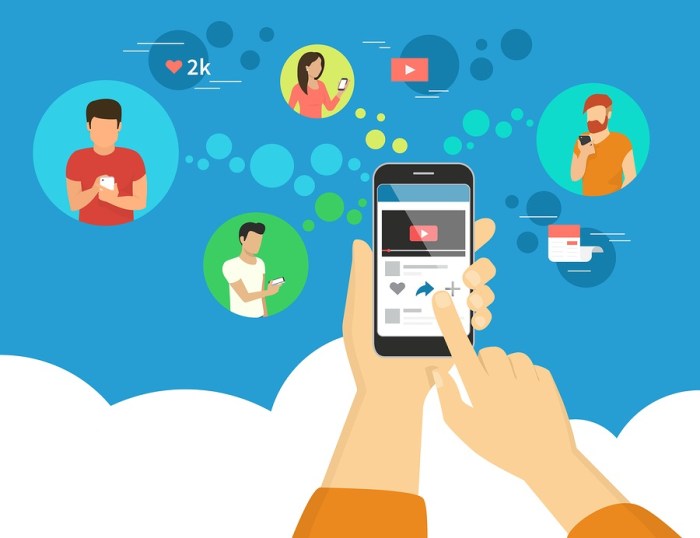Creating Social Media Content for Events dives into the world of captivating content creation for event promotion, offering insights and strategies to elevate your social media presence. From understanding your audience to crafting compelling hashtags, this guide has you covered.
Understanding the Audience: Creating Social Media Content For Events
When creating social media content for events, it is crucial to first understand the audience you are trying to reach. By identifying the target audience and their demographics, you can tailor your content to better engage and resonate with them.
Identify the Target Audience
To start, you need to determine who your target audience is for the event. Consider factors such as age, gender, location, interests, and behavior patterns. This information will help you create content that is relevant and appealing to your audience.
Impact of Audience Demographics
The demographics of your audience can greatly impact the type of content you create. For example, if your event is targeting a younger audience, you may want to use more trendy language and visuals to capture their attention. On the other hand, if your audience is older, you may need to focus on more formal language and informative content.
Tailoring Content to Different Audience Segments
One strategy for tailoring content to different audience segments is to create different types of content for each group. For example, you could use interactive posts for a younger audience, while providing more detailed information for an older audience. Additionally, you can personalize content based on the interests and preferences of each segment to increase engagement and relevance.
Content Types and Formats
When it comes to promoting events on social media, there are various types of content that can be utilized to engage the audience and create excitement. These include images, videos, and text-based content, each with its own strengths and effectiveness.
Types of Content
- Images: Eye-catching visuals can quickly grab the attention of users scrolling through their feeds. They are great for showcasing event highlights, speakers, performers, or venue details.
- Videos: Dynamic and engaging, videos offer a more immersive experience for the audience. They can be used for event teasers, behind-the-scenes glimpses, or interviews with key participants.
- Text-based content: While not as visually striking as images or videos, text-based content is essential for providing detailed event information, such as schedules, ticketing details, and important announcements.
Effectiveness Comparison
Images are effective for grabbing attention, videos for engagement, and text for providing information.
Images are great for creating initial interest, videos can deepen engagement, and text is crucial for conveying important details.
Engaging Content Formats
- Teaser Trailers: Create short, visually appealing videos that offer a sneak peek of what attendees can expect at the event. Use music, fast cuts, and exciting visuals to build anticipation.
- Countdown Posts: Generate excitement by counting down the days or hours until the event. Use compelling graphics and engaging captions to keep the audience excited and informed.
- Speaker Spotlights: Highlight key speakers or performers with engaging visuals and brief descriptions of their background and expertise. This can help build credibility and excitement around the event.
Platform Selection

When it comes to choosing the right social media platforms for event promotion, it’s crucial to consider where your target audience spends most of their time online. Each platform has its own strengths and weaknesses, so understanding these can help you make an informed decision.
Advantages and Disadvantages of Different Platforms, Creating Social Media Content for Events
- Facebook: With a large user base, Facebook allows for detailed event pages, easy sharing, and targeted advertising. However, organic reach can be limited, and younger audiences may not be as active.
- Instagram: Ideal for visual content, Instagram is great for showcasing event photos and videos. Hashtags can increase visibility, but the platform is primarily used by a younger demographic.
- Twitter: Known for real-time updates, Twitter can help create buzz around your event. However, tweets have a short lifespan, and character limits can be restrictive.
- LinkedIn: Best for professional events, LinkedIn allows for networking with industry professionals. However, the audience may be more limited compared to other platforms.
Tips for Cross-Promoting Content
- Create a consistent brand voice across all platforms to maintain cohesion.
- Use unique content tailored to each platform’s strengths, such as videos for Facebook and Instagram Stories.
- Cross-promote by sharing posts from one platform to another, driving traffic across channels.
- Engage with your audience on all platforms to build a community and increase event visibility.
Content Calendar and Scheduling

Creating a content calendar is crucial for promoting events on social media, ensuring a consistent flow of engaging posts leading up to the big day. Scheduling posts strategically can help maximize reach and engagement, ultimately driving more excitement and attendance to the event. Timing plays a key role in the success of event-related content, as posting at the right moments can capture the audience’s attention and drive interaction.
Sample Content Calendar
- Week 1: Teaser post announcing the event date and theme
- Week 2: Behind-the-scenes sneak peek of event preparations
- Week 3: Interactive poll asking followers for event preferences
- Week 4: Highlighting guest speakers or performers
- Week 5: Countdown to the event with daily updates and reminders
Best Practices for Scheduling Posts
- Use social media management tools like Hootsuite or Buffer to schedule posts in advance
- Consider the peak hours of your target audience for each platform
- Mix up content types to keep the feed interesting and engaging
- Monitor engagement metrics to identify the best times for posting
Importance of Timing in Posting
Posting event-related content at the right time can significantly impact its visibility and engagement. For example, posting during peak hours when your audience is most active can increase the chances of your posts being seen and interacted with. Additionally, timing your posts strategically can help build anticipation and excitement leading up to the event, driving attendance and participation.
Hashtag Strategy
Hashtags are like the secret sauce to make your event stand out in the social media crowd. They help categorize content, increase visibility, and connect with a wider audience. It’s like giving your event a VIP pass to the coolest parties on the internet!
Creating Event-Specific Hashtags
When creating event-specific hashtags, keep it simple, catchy, and relevant to your event. Make sure it’s easy to remember and unique to avoid getting lost in a sea of other hashtags. For example, if your event is a music festival called “Summer Sounds,” a good hashtag could be #SummerSoundsFest.
- Include the event name or theme in the hashtag.
- Avoid using spaces or special characters.
- Check if the hashtag is already in use to prevent confusion.
- Promote the hashtag across all your event marketing materials.
Leveraging Trending Hashtags
Riding the wave of trending hashtags can give your event a massive visibility boost. Keep an eye on the latest trends and find ways to incorporate them into your posts. For example, if your event is a food festival and #TacoTuesday is trending, you could use it in your posts to attract more foodies to your event.
- Research trending hashtags related to your event industry.
- Create posts that seamlessly integrate trending hashtags.
- Engage with other posts using the same trending hashtags to increase visibility.
- Don’t force a trending hashtag if it’s not relevant to your event.
